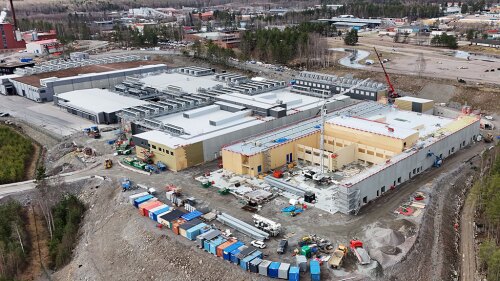Carbon is not only relevant in today’s marketplace as it affects the global economy; it is also having a rising influence in the regulatory environment.
Issues related to carbon management and reductions are ubiquitous in the popular and scientific press these days. More and more companies in various industries are beginning to look at their carbon footprint and how they can best measure, monitor, and mitigate carbon emissions related to their output. For architects and engineers, the work involves the design, construction, and operation of the built environment, one of the highest energy-consuming and carbon-emitting business sectors there is. In 2002, U.S. buildings in the end-user segment alone accounted for 43 percent of the country’s carbon emissions, according to the Pew Center on Global Climate Exchange’s Climate Change 101 report. Moreover, according to environmental advocacy group Architecture 2030, as much as 76 percent of the energy produced by domestic coal-fired plants is used to support the built environment.
Carbon is not only relevant in today’s marketplace as it affects the global economy; it is also having a rising influence in the regulatory environment. Consequently, building designers know that what they do will have a tremendous impact on the success of their clients and their buildings, future communities, and preservation of the environment. Accordingly, they review opportunities for efficiency, providing options for consideration by building owners, developers, and facility managers.
A carbon footprint is the total greenhouse gas (GHG) emissions caused directly and indirectly by an individual, organization, event, or person. The six most common GHGs that are discussed in various protocols and initiatives are carbon dioxide, methane, nitrous oxide, hydrofluorocarbons, perfluorocarbons, and sulfur hexaflouride. The key GHG is carbon dioxide, which is a derivative of the combustion of fossil fuels, mainly by utility plants and for transportation and industrial production.
On the global front, the United Arab Emirates led the world in CO2 production in 2009 with 30 metric tons per capita, followed by the United States, Australia, and Canada, according to the International Energy Agency’s Key World Energy Statistics in 2009. Tellingly, although China and the United States are neck and neck in emitting up to 6 billion metric tons of carbon annually, China has a significantly lower per-capita average—4 metric tons for each of its 1.5 billion citizens, compared with 19 metric tons for each of the 380 million U.S. citizens. This illustrates the enormous opportunity available to innovate and implement strategies to reduce carbon emissions.
In response to the need for reduced carbon emissions, discussions of cap and trade programs are beginning. Many corporations, government agencies, nonprofit organizations, households, and other public/private entities are voluntarily reporting their greenhouse gas emissions. However, knowledge of how to identify and measure the rate of carbon emissions is fundamental before review of the market-based options available.
According to the 2002 figures from Climate Change 101, following the building sector at 43 percent are the transportation sector at 32 percent of all U.S. end-user carbon emissions from the combustion of fossil fuels, and the industrial sector at 25 percent. In the building sector itself, commercial buildings purchase 36 percent of all electricity generated. According to 2008 data from the Energy Information Administration, electrical consumption in the commercial sector is driven by lighting, 38 percent; heating, ventilation, and air conditioning (HVAC), 30 percent; other miscellaneous uses such as elevators and appliances, 15 percent; refrigeration, 11 percent; and office equipment and computers, 6 percent.
Businesses can assess their carbon emissions through rates published by utility companies according to geography. Emissions are further categorized by type —carbon dioxide, methane, and nitrogen oxides; methane and nitrogen oxides are often converted to a carbon dioxide equivalent in order to simplify reporting to a common metric. Analysis of this information can be helpful in developing targets for GHG emissions and their reduction. Design engineers can then help building owners evaluate and calculate their carbon output. Tools are also available to the public on the internet that can help businesses convert energy consumption and carbon emissions to sustainability equivalencies.
Business owners wanting to report their emissions to existing protocols and trading programs need to do so in three scope areas:
- direct sources—company emissions through vehicle use and use of on-site fuels (boilers, cogeneration plants, etc.);
- indirect sources—emissions through such sources as electricity purchased from a utility plant; and
- other indirect sources—emissions through employee business travel, waste disposal, contractor-owned vehicles, and production of waste materials.
The second scope, indirect sources, accounts for a large share of business emissions because of the reliance of buildings on electricity generation, though the third scope also produces a fair share of business emissions.
Once carbon emission rates are measured, the next step is to develop appropriate mitigation strategies to reduce those emissions.
By the time energy purchased from the utility plant is received at the building site, it has already experienced a tremendous amount of energy loss along the way. The coal-fired power plants that dominate the U.S. utility sector account for up to 70 percent of losses alone because converting coal to electricity expends a great deal of energy. Once on a transmission line running many miles, another 9 percent of the energy is lost up until it reaches the building site meter. These losses represent useless megawatts, though generation of this energy still produces carbon emissions. Incorporating high-performance solutions can help resolve energy waste and other inefficiencies, and thereby reduce carbon emissions. The following is an approach to consider when developing specific strategies for a building.
- Reduce or eliminate loads where possible. Buy Energy Star equipment. Also, eliminate unnecessary software programs on computers in order to free up space and bandwidth so they can do more things, and to eliminate inefficient steps or the need for additional servers. Other ways to reduce loads include increasing the amount of insulation in the building facade, optimizing glass performance, using solar shading, and employing more efficient lighting systems.
- Leverage the local climate and geology. Use natural daylighting to reduce the need for electric lighting. If the climate is conducive, consider providing operable windows for natural ventilation to reduce the need for mechanical refrigeration. Incorporate passive solar heating features to limit the need for mechanical heating. And if the site geology is appropriate, consider the use of geothermal heating and cooling systems to take advantage of the stable temperature of the earth year-round.
These two steps alone can yield a dramatic reduction in a building’s carbon footprint, accounting for savings of 30 to 50 percent.
Other steps include the following:
- Optimize active systems. Incorporate high-efficiency HVAC, lighting, and electrical equipment and systems to supplement the passive strategies. Use the right size of equipment and systems for what they are providing; do not oversize them. Include appropriate instrumentation for control of the passive and active systems and equipment, and provide feedback to building owners and facility managers on the actual building performance. Also, be sure to embrace the commissioning process so that the building actually performs as intended from the start rather than after years of trial and error.
- Incorporate renewable natural energy sources. Renewable energy technologies include solar photovoltaics, solar thermal energy, wind turbines, hydropower, biomass, biofuel, and geothermal heat. High oil prices, peak oil, and increasing government support are driving growing renewable energy incentives and commercialization of these technologies. Commitment to this approach often involves an initial increased cost, but the return is significant for including a smaller, appropriately sized, and optimized renewable energy system in a project.
- Divert waste from landfills. Build only what is needed. Building less equals less waste and therefore reduces the amount of waste diverted to landfills. In addition, a smaller, more efficient building has less wasted space that requires heating, lighting, and air conditioning, so it can be inherently more efficient.
- Reduce use of hazardous materials. Avoid using materials that eventually end up in the biosphere as a pollutant—mercury in mercury-filled lamps, refrigerants, etc.
Some level of optimization can be achieved if any of the above strategies are incorporated, but much more significant results are possible when the entire approach is embraced. The best results require owners, contractors, engineers, and architects to collaborate to help “engineer the architecture” of the building.
Essentially, two market-based alternatives to emission reductions exist: cap and trade, and carbon taxation. The Chicago Climate Exchange initiated the first voluntary cap and trade system in North America in 2003, but many other exchanges are available in the market today. In other parts of the world, mandatory market mechanisms exist.
The carbon tax is a more straightforward approach: companies are taxed by the government according to their overall carbon emissions.
Governments around the world appear to be taking a more active role to control emissions through some type of regulation, but most economists favor carbon trading as an approach because it can stimulate private sector investment in and possibly adoption of new technologies. Skeptics of emissions trading favor the tax approach as easier to implement and enforce.
Understanding the market forces, trends, and challenges involved in carbon emissions and their reduction, as well as being able to identify and measure current emissions, are the first steps that must be taken. High-performance strategies can then be considered and implemented to achieve efficiencies, as well as reach goals for environmental stewardship.
Market forces continue to drive this movement from one of a solely environmental nature to one in which it is also now smart business.
See, Tools and Resources Available for Carbon Management for links to online information on how to calculate, report, reduce, and offset carbon emissions.




